
Fluctuations in climate are one of the major drivers of evolutionary change as they can affect every aspect of an ecosystem, from plant life to predators.
Larger species may perish in hot climates because they have a tough time dissipating heat. Likewise, smaller species have difficulty maintaining heat during times of extreme cold.
Evolution: Climate models this phenomenon as it incorporates a shifting climate into the game's dynamic ecosystem.
New Components
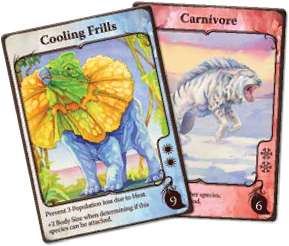
Trait Cards
The new trait cards each have 1-4 black climate icons on them.
The black Sun icons ( ) move the climate warmer and the black Snowflake icons (
) move the climate warmer and the black Snowflake icons ( ) move the climate colder.
) move the climate colder.
Climate Board
The Climate Board replaces the Watering Hole. It has a track on the top which records the climate and its effects each round. The white Snowflakes on the 3 extreme regions on the cold side represent Population loss due to cold.
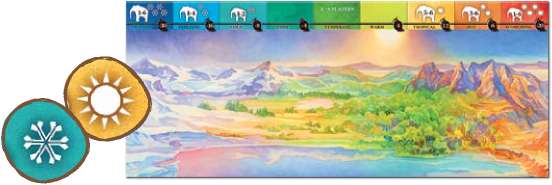
The white Suns on the 3 extreme regions on the hot side represent Population loss due to heat.
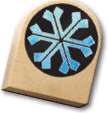
Climate Marker
The Climate Marker keeps track of the climate each round.
Climate Event Cards
There is a deck of 15 Hot-side Climate Event cards and a deck of 15 Cold-side Climate Event cards. The back sides these cards indicate where each deck goes on the Climate Board.
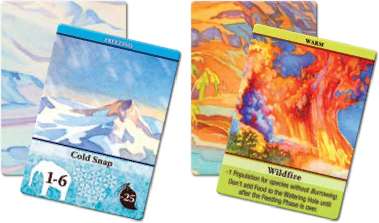
In order to convert Evolution into Climate you will need to remove all copies of Burrowing, Defensive Herding, Ambush, and Carnivore from the base game. Then shuffle the conversion kit Trait Cards into the deck.
Setup
Set up the Evolution base game as normal with the following additional steps:
Assemble the Climate Board. This replaces the Watering Hole. One side is for 2-3 player games and the other side is for 4-6 player games. Remove cards from the deck depending upon the number of players. Set the cards aside to be used for the final round of the game.
- 2 Players: Remove half the cards (it does not need to be exact)
- 3 Players: Remove 60 cards
- 4 Players: Remove 30 cards
- 5 & 6 Players: Do not remove cards
Put the Climate Marker in the TEMPERATE zone of the Climate Board. Shuffle and place the 15 card deck of Cold Side Climate Events on the bottom left side of the Climate Board. Draw the top card and place it face up under the Climate zone named on the card.
Shuffle and place the 15 card deck of Hot Side Climate Events on the bottom right side of the Climate Board. Draw the top card and place it face up under the Climate zone named on the card.
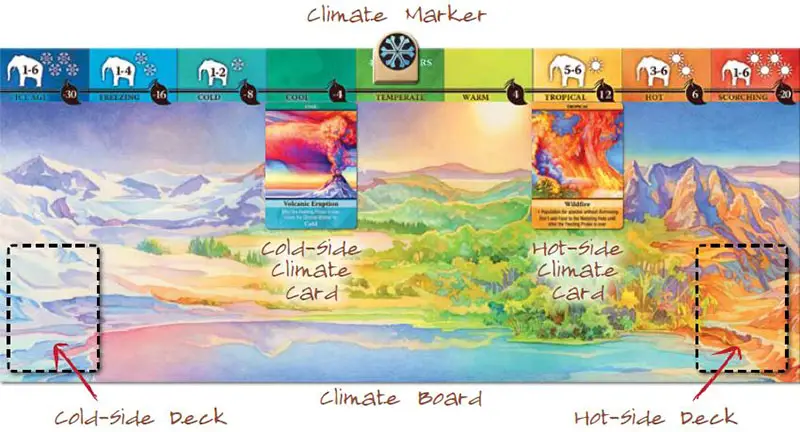
Object of the Game
The goal of Evolution: Climate is the same as the Evolution base game: to thrive in the midst of an ever-changing ecosystem.
Game Play
Evolution: Climate uses the same rules as the Evolution base game with 4 changes. One of these changes is the addition of the Modify Environment phase which takes place between the Play Cards phase and the Feeding phase.
Phase 1: Deal Cards
Deal each player 4 cards from the Draw Deck (instead of 3), plus 1 card for each species they have in front of them.
Phase 3: Play Cards
Each species may have up to 4 different traits (instead of 3).
After a player has finished playing cards for the round, they may return any number of cards from their hand to the bottom of the face-down Draw Deck (to be dealt at a later time) and draw the same number of cards from the top of the Draw Deck.
A player may not return more cards than are available in the Draw Deck. The newly drawn cards cannot be played as traits until Phase 3 {Play Cards) of the next round.
Phase 4: Modify Environment
This phase will determine whether the Climate Marker shifts into a new Climate zone and the amount of food that will be added to (or subtracted from) the Watering Hole during the Feeding phase. Reveal the Food Cards on the Watering Hole and complete the following steps in order:
1. Adjust the Climate
Move the Climate Marker 1 zone warmer if there are more Sun icons on the Food Cards than Snowflakes icons.
Move the Climate Marker 1 zone colder if there are more Snowflake icons on the Food Cards than Sun icons.
The Climate Marker does not move if there are an equal number of Sun and Snowflake icons on the Food Cards.
2. Trigger Climate Events
The Climate Marker indicates the current Climate zone. If there is a Climate Event Card in the current Climate zone, read the card and do what it says.
Read the Reference Section - Climate Event Cards if you have questions about how to resolve a Climate Event Card. Resolved Climate Event Cards are placed at the bottom of the appropriate deck (unless otherwise indicated).
When a Cold Snap or Heat Wave occurs, disregard the Climate effects on the current Climate zone for that round and use the Climate effects on the Climate Event Card instead.
3. Climate Population Loss
Six of the Climate zones contain a Body Size icon and a Climate icon (Suns or Snowflakes).
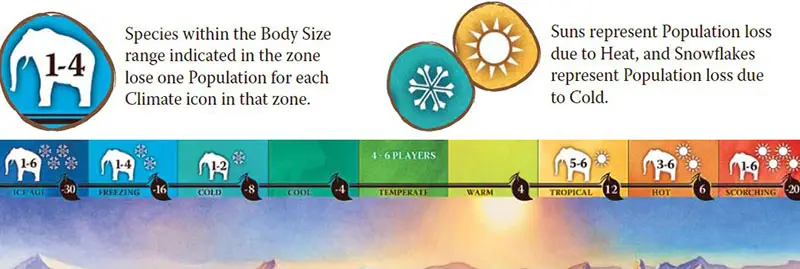
- Ice Age: Every species loses 4 Population due to the cold.
- Freezing: Each species of Body Sizes 1-4 loses 2 Population due to the cold.
- Cold: Each species of Body Size 1 or 2 loses 1 Population due to the cold.
- Tropical: Each species of Body Size 5 or 6 loses 1 Population due to the heat.
- Hot: Each species of Body Sizes 3-6 loses 2 Population due to the heat.
- Scorching: Every species loses 4 Population due to the heat.
Every species in play loses Population at the same time according to the current Climate zone. Species that go below 1 Population go Extinct.
Species may have protective traits that prevent some or all of this Population loss. The effects of protective traits are cumulative. For example, a species can prevent up to 3 Population loss due to Heat if it has Burrowing, Migratory, and Nocturnal.
4. Adjust the Plant Food
Add (or remove) Plant Food to (or from) the Watering Hole based upon the Food Cards and the Climate zone.
The number in the leaf at the bottom right of each Food Card represents the amount of Plant Food that will be added to the Watering Hole. First total all of these numbers, then adjust that amount by the amount printed in the leaf on the current Climate zone.
Sometimes there will be no food in the Watering Hole for a round and sometimes food will be removed! This is not unusual when the Climate is very cold.
5. Replace Climate Event Card
If a Climate Event card was triggered, draw a new Climate Event card from the appropriate deck (cold or hot) and place it under the appropriate Climate zone.
This new Climate Event card cannot get triggered until the next round. There will always be 2 face-up Climate Event cards on the Climate track at the beginning of each round (1 cold and 1 hot), and only 1 Climate Event can get triggered each round.
Cards
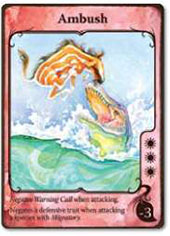
Ambush
Allows a Carnivore to attack a species protected by the Warning Call trait.
A Carnivore with Ambush may ignore one defensive trait on any species that has the Migratory trait when determining if it can attack that species.
Burrowing
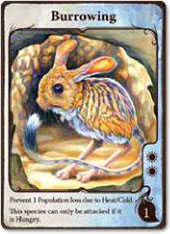
A Carnivore cannot attack this species unless one or more of its Population is hungry. Normally this protection is only active when the Burrowing species is fully fed, but a species with Burrowing and Hibernation is protected when all but 2 of their Population is fed.
Population loss due to both heat and cold is reduced by 1 for this species. For example, in the Ice Age Climate zone, there are 4 Snowflake icons representing 4 Population lost due to cold.
A species with Burrowing negates 1 of those Snowflakes, so it loses only 3 Population.
Burrowing enables species to hide from predators, making them vulnerable only when they leave their lair to find food. Burrowing also provides protection from extreme temperatures.
A burrowing species can escape direct sunlight by retreating into the cooler ground. Likewise, a burrower can escape the cold winter nights by retreating to a well-insulated lair.
Cooling Frills
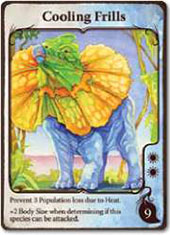
Add 2 to this species' Body Size when determining if a Carnivore can attack it. A species with Body Size 6 and Cooling Frills will have an effective Body Size of 8. Cooling Frills does not increase the amount of Meat Food that a Carnivore takes after an attack.
Population loss due to heat is reduced by 3 for this species. For example, in the Scorching Climate zone there are 4 Sun icons representing 4 Population lost due to heat.
A species with Cooling Frills negates 3 of those Sun icons, so it loses only 1 Population.
The most efficient way for an animal to dissipate heat is to have a high ratio of body surface area compared to its weight.
A large frill, such as those on the Frilled-Neck Lizard, allows an animal to cool itself by unfurling its frills. This gives the species a temporary increase in their body's surface area from which to dissipate heat.
An additional benefit is that the frills can be expanded to deceive predators into thinking the animal is larger than it is.
Defensive Herding
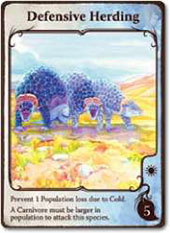
A species with Defensive Herding may not be attacked unless the attacking Carnivore has a Population that is greater than the Population of the species with Defensive Herding.
Population loss due to cold is reduced by 1 for this species. For example, in the Ice Age Climate zone, there are 4 Snowflake icons representing 4 Population lost due to cold.
A species with Defensive Herding negates 1 of those Snowflakes, so it loses only 3 Population.
Herding is not only used as a defensive mechanism, but also as a way of sharing body heat to stay warm in the cold.
Emperor Penguin colonies huddle together to conserve body heat and shield themselves from the frigid winds of Antarctica.
Each penguin takes a turn on the outside of the huddle before shifting back to the inside to get warm again.
Heavy Fur
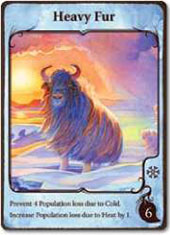
Population loss due to cold is reduced by 4 on this species. For example, in the Ice Age Climate zone there are 4 Snowflake icons representing 4 Population lost due to cold.
A species with Heavy Fur negates all 4 of those Snowflakes and loses no Population instead.
Population loss due to heat is increased by 1 for this species. For example, in the Scorching Climate zone there are 4 Sun icons representing 4 Population lost due to heat. A species with Heavy Fur loses 5 Population instead.
Hibernation
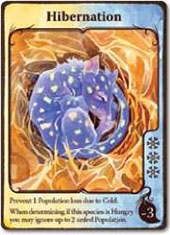
Up to 2 Population may be ignored when determining if this species is hungry. Those Population don't need to be fed during Phase 5: Feeding and they won't be lost due to hunger at the End of Feeding.
A species with Burrowing and Hibernation is protected when all but 2 of their Population is fed.
Population loss due to cold is reduced by 1 for this species.
For example, in the Ice Age Climate zone, there are 4 Snowflake icons representing 4 Population lost due to cold. A species with Hibernation negates 1 of those Snowflakes, so it loses only 3 Population.
Migratory
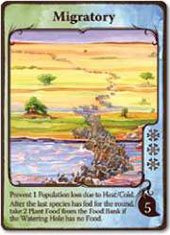
After all species have finished feeding for the round, this species takes up to 2 Food from the Food Bank if the Watering Hole is empty (provided it has enough hungry Population). This occurs even if there was no Watering Hole Food during the round.
Population loss due to both heat and cold is reduced by 1 for this species. For example, in the
Ice Age Climate zone, there are 4 Snowflake icons representing 4 Population lost due to cold. A species with Migratory negates 1 of those Snowflake icons, so it loses only 3 Population.
Many species migrate with the seasons, travelling to new locations to stay within a comfortable climate. But this passage is not without peril. Predators often attack migrating species, thinning their herds as they make their long and arduous journey across the planet.
Mud Wallowing
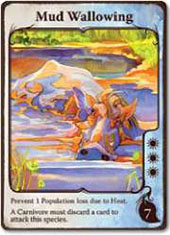
A player must discard a card from their hand to the faceup Discard Pile before their Carnivore may attack a species with the Mud Wallowing trait.
A card must be discarded before each attack. Population loss due to heat is reduced by 1 for this species
For example, in the Scorching Climate zone, there are 4 Sun icons representing 4 Population lost due to heat. A species with Mud Wallowing negates 1 of those Sun icons, so it loses only 3 Population.
Some animals wallow in mud to regulate their body temperature and keep cool. It takes longer for water to evaporate when it is mixed with mud, which means the body is being cooled for a longer period of time.
Wallowing in mud may also serve as camouflage against predators.
Nocturnal
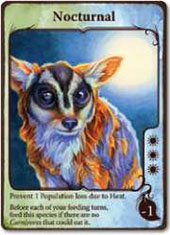
Before each of your feeding turns, this species (Carnivore or Non-Carnivore) may take a free feeding action if there are no Carnivores in play that could eat it.
You may feed the same species again during your normal feeding action or you may feed a different species. The additional feeding triggers cards such as Cooperation and Foraging.
To determine if Nocturnal is in effect, a Carnivore with Intelligence is considered able to eat the Nocturnal species only if the Carnivore's owner has enough cards in hand to get past all of the Nocturnal species' defensive traits.
Carnivores that are fully fed are unable to attack any species. Population loss due to heat is reduced by 1 for this species. For example, in the Scorching Climate zone, there are 4 Sun icons representing 4 Population lost due to heat. A species with Nocturnal negates 1 of those Sun icons, so it loses only 3 Population.
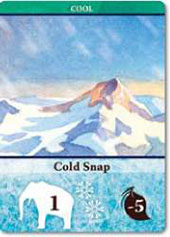
Cold Snap
When a Cold Snap occurs, disregard the Climate effects on the current Climate zone for that round and use the Climate effects on the Climate Event card instead.
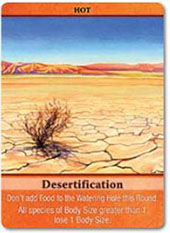
Desertification
When Desertification occurs, every species loses 1 Body Size. Species that have 1 Body Size remain at 1 Body Size.
Do not add Food to the Watering Hole if the food total is positive for the round, but remove food as normal if the food total is negative.
Weather patterns are constantly shifting in response to the changing geography.
As landmasses move, ocean currents change, and mountain ranges rise and fall, a new mountain range may deprive a nearby region of rain clouds for many hundreds of thousands of years, turning today's flourishing landscape into tomorrow's barren desert.
Everything is in flux when looked at over eons of time. Even the Sahara desert was once a lush savanna.
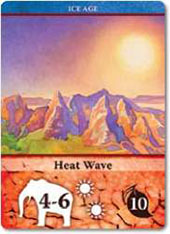
Heat Wave
When a Heat Wave occurs, disregard the Climate effects on the current Climate zone for that round and use the Climate effects on the Climate Event card instead.
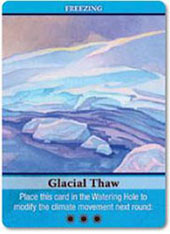
Glacial Thaw
When Glacial Thaw occurs, place the Glacial Thaw card face-up on the Watering Hole section of the Climate Board.
The 3 Sun icons on that card will be added to the Climate icon count when the Food Cards are revealed during Phase 4: Modify Environment of the next round.
Draw another Climate Event card as normal during step 5 of the phase in which Glacial Thaw was triggered.
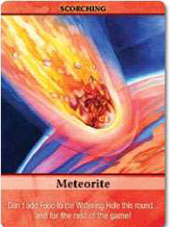
Meteorite
When a Meteorite impact occurs, do not add Food to the Watering Hole if the Food total is positive for the round, but remove Food as normal if the Food total is negative.
Do this every round until the end of the game! Population loss due to the heat and cold occurs as normal.
The impact of a massive meteorite is one of the most cataclysmic events that can occur. It has the potential to alter the orbital path of a planet while ejecting enormous amounts of material into the air Some of this material will fall back to Earth, igniting forests and creating multiple firestorms.
The remaining particles stay in the atmosphere for years, blocking the sunlight needed for plant life to survive.
The mass extinction of plant and animal life around 66 million years ago is generally thought to be the result of a massive comet or asteroid impact at the end of the Cretaceous period known as the Cretaceous-Paleogene extinction event.
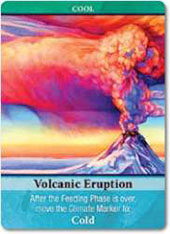
Volcanic Eruption
When a Volcanic Eruption occurs, you will move the Climate Marker to the designated Climate zone at the end of Phase 5 (Feeding).
The next round of the game will start with the Climate Marker in the new Climate zone.
Massive volcanic eruptions can jettison large columns of ash and sulphur high into the stratosphere. Sulphur reacts in the upper atmosphere to create an atmospheric haze that blocks the solar radiation, significantly cooling the planet for many years afterwards.
The eruption of Krakatoa in 1883 lead to a significant reduction of average summer temperatures across the Northern hemisphere for over 5 years.
Wildfire
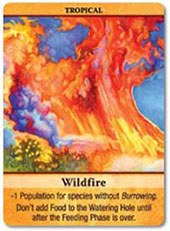
When a Wildfire occurs, all species without the Burrowing trait lose 1 Population. This Population loss is not considered loss due to heat so it cannot be prevented with heat related traits.
The Food that would normally be added to the Watering Hole this round is instead set aside.
This Food is added to the Watering Hole before Phase 1: Deal Cards of the next round.
Wildfires initially cause devastation to the environment, but are actually critical to future growth. The fire breaks down organic elements into nutrients that are then washed back into the soil by rain.
The result is exceptionally fertile soil. Some seeds actually require fire to break their outside coating before they can germinate.
End of the Game
If you are playing a game with 2-4 players, instead of shuffling the discard pile for the final round, use the cards that were removed during set-up. Scoring is the same as in the Evolution base game.
2-player Rules
The 2-player version of Evolution: Climate is played with the same rules as the normal game except a species can have a maximum of 3 traits instead of 4.
Variant: No Climate Events
Evolution: Climate was originally designed without Climate Event cards. We recommend playing without these cards if anyone at the table is new to the game. You will get a perfectly balanced gaming experience with a little less chaos (and perhaps a little less story-telling).
Continue Reading


